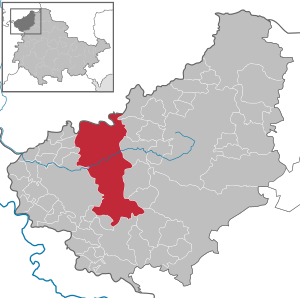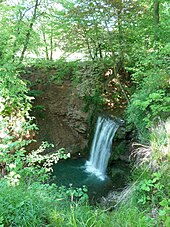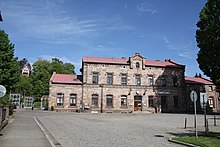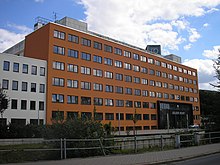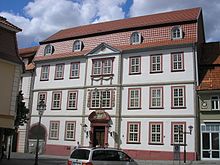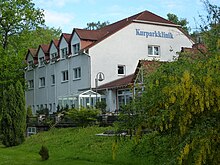Heilbad Heiligenstadt
| coat of arms | Germany map | |
|---|---|---|

|
Coordinates: 51 ° 23 ' N , 10 ° 8' E |
|
| Basic data | ||
| State : | Thuringia | |
| County : | Eichsfeld | |
| Height : | 255 m above sea level NHN | |
| Area : | 70.88 km 2 | |
| Residents: | 17,129 (Dec. 31, 2019) | |
| Population density : | 242 inhabitants per km 2 | |
| Postal code : | 37308 | |
| Area code : | 03606 | |
| License plate : | EIC, HIG, WBS | |
| Community key : | 16 0 61 045 | |
| LOCODE : | DE HHI | |
| Community structure: | 5 districts | |
| Address of the municipal administration: |
Marktplatz 15 37308 Heilbad Heiligenstadt |
|
| Website : | ||
| Mayor : | Thomas Spielmann ( BI People for Heiligenstadt ) | |
| Location of the community Heilbad Heiligenstadt in the district of Eichsfeld | ||
Heiligenstadt is the county town of the district Eichsfeld in Thuringia ( Germany ) and a recognized Sole - spa .
geography
Location
Heiligenstadt is located in Obereichsfeld , about 14 km (as the crow flies ) east of the border triangle between Hesse - Lower Saxony and Thuringia in the west of the Eichsfeld district. The city is traversed by the Leine in an east-west direction , into which the Geislede , coming from the southeast, flows near the city center .
The Iberg ( 453.2 m above sea level ) rises south of Heiligenstadt in the up to 467.2 m high Heiligenstädter Stadtwald , which belongs to the northern part of the Eichsfeld-Hainich-Werratal Nature Park . In the city forest on the Elisabethhöhe is an early medieval , three-hectare rampart, which probably served as a refuge for the royal court. A wall with a height difference of four meters is still there.
Depending on the calculation method, there is also a center of Germany in the area of the city near Flinsberg.
City structure
Heiligenstadt has 5 districts:
During the GDR era, new prefabricated housing estates emerged, for example on the Liethen on the northern and on the Rinne on the southeastern outskirts, they are still part of the core city.
Origin of name
The name Heiligenstadt is associated for the first time with the St. Martin monastery, which was built around 960 . The place was regarded as a holy place because, according to credible local tradition, it initially bore the name "Zuenchen" (zum Hænchen = zum Hain, Hagen), that is, it was a pre-Christian place of worship , which the early Christians usually moved, through their own religious monuments and Churches to "demonize" and appropriate these places. In 973 the name seems to have been changed to “Place of the Saints” because the relics of Saints Sergius and Bacchus were kept there. The relics of Saints Aureus and Justinus were added later. The name of the holy place (Heiligenstadt) was then also transferred to the adjacent settlement and later city.
history
Middle Ages and Early Modern Times
In Franconian times the place was important as a manor house . The area around Heiligenstadt was given to the Archbishop of Mainz very early on . The Königspfalz is documented in 973 and 990 with Emperors Otto II and Otto III. as well as 1153 and 1169 with Friedrich I. Barbarossa in connection. The first documentary mention of Heiligenstadt took place on November 23, 973. In 1227 the Archbishop of Mainz Siegfried II granted Heiligenstadt city rights. In 1335 the “arbitrariness” was enacted, the city law comprising 160 articles.
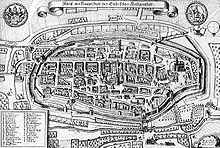
The governorship of the Eichsfeld was exercised from Rusteberg Castle until it was transferred back from Rusteberg to Heiligenstadt in 1540. During the Peasants' War , a bunch of rebellious peasants wanted to call on the Heiligenstadt council to join the revolutionary league, but were not allowed into the city. Only Thomas Müntzer and Heinrich Pfeiffer were able to present their demands to the council and achieved that no more Roman Catholic priests should hold mass, but that Protestant pastors should preach the word of God in future . After the failure of the Peasants' War, these concessions were reversed. The Catholic Church regained its religious and political influence based on the Archbishopric Mainz possessions in Eichsfeld. Crucial for regaining the population for the Catholic faith was the pastoral care of the Jesuits, who came to Heiligenstadt in 1574 and u. a. founded a college . During the Thirty Years War from 1618 to 1648, the city was devastated several times.

In 1736 the new construction of the Mainz Castle took place.
19th and 20th centuries
When the rule of the Archbishops of Mainz over the Eichsfeld ended in 1802 in the course of secularization , Heiligenstadt, which was also part of the Kurheinische Reichskreis , became Prussian as part of the media principality of Eichsfeld. Afterwards the city belonged to the Kingdom of Westphalia from 1807 to 1813 and was the seat of the prefecture of the Harz department . As a result of the Congress of Vienna , the city became Prussian again in 1815 and, as the district town of the district of Heiligenstadt, belonged to the administrative district of Erfurt in the Prussian province of Saxony .
The Kneipp bath was built in 1929. Until 1933 National Socialism found hardly any supporters in the almost completely Catholic milieu of Heiligenstadt. Even after the “ seizure of power ” the NSDAP received only 19% of the votes in the Reichstag election on March 5, 1933 (compared to 66% for the center), one of its worst results in the whole of Germany. The synagogue was desecrated on November 9, 1938 . A plaque on the building, which was used as a residential building until 2011, reminded of this. On September 7, 2011, the former synagogue was demolished to make way for a shopping center. A care facility is now located on the grounds of the former church.
On April 5, 1945, there was an American fighter-bomber attack with five civilian deaths and damage to buildings. On April 9th, Heiligenstadt was handed over without a fight. 3,000 German wounded lay in eight hospitals in the city. The current district of Günterode was also occupied on April 9, 1945. This was preceded by artillery shelling with damage to houses and the church.
According to the decisions of the Yalta Conference , the US troops withdrew on 1/2. July 1945 from Heiligenstadt; the Red Army advanced in their place . Heiligenstadt became part of the Soviet zone of occupation .
In the still strongly Catholic milieu of Heiligenstadt, the SED initially found hardly any supporters during the GDR era . With the intention of “proletarianizing” Heiligenstadt and Eichsfeld as a whole, the Eichsfeld Plan envisaged the influx of people from other parts of the GDR in the course of industrialization. The VEB Nortak tobacco factories Nordhausen built and maintained the operating camps "Old Castle" for the children of his company employees.
In October 1989 demonstrations began in Heiligenstadt as part of the Peaceful Revolution in the GDR. In 1994 Heiligenstadt became the district town of the district of Eichsfeld (emerged from the merger of the districts of Heiligenstadt and Worbis ).
Since January 1, 2019, Bernterode (near Heilbad Heiligenstadt) has been part of Heilbad Heiligenstadt.
Spa
Even if the title Kneippbad was awarded as early as 1929 and the name was changed to “Heilbad Heiligenstadt” in 1950, the city was administratively only known as Heiligenstadt during the GDR era. The usual place for the title bath in front of the official place name for such a spa was omitted. In 1990 the official stamp of the city administration still read " Council of the City of Heiligenstadt".
But because the official postal name of the city of Heilbad Heiligenstadt was or z. B. Postcard publishers or the Kreissparkasse used the title Heilbad , the city had three different city names in the period from 1950 to 1990: Heiligenstadt without any addition, preceded by Heilbad or followed by (Eichsf.) .
In 1990 the city administration and first of all its mayor began to expand the spa business. Bad status gained in importance. In addition, as a result of the reunification , several places with the name Heiligenstadt came into view, which made confusion possible. A differentiator was needed.
Initially, the city was denied the official status of a health resort due to a lack of existing facilities. The city appealed against this decision. She used the time of editing and the relatively unlawful space shortly after the reunification and created facts. So spa departments and the like were built and, above all, the title spa officially integrated into the place name. When a site inspection took place a year and a half later, a place was presented that was called Heilbad Heiligenstadt and was a health resort. Approval has been granted.
Population development
Development of the population (December 31) :
|
|
|
|
|
|
|
- Data source from 1994: Thuringian State Office for Statistics
Religions
The Eichsfeld and thus also Heiligenstadt is influenced by Roman Catholicism. In addition to the Catholic churches, there are numerous chapels and Catholic institutions in Heiligenstadt. In 1862 the German branch of the Order of the Sisters of St. Maria Magdalena Postel , also known as the Heiligenstadt School Sisters .
The oldest Jewish community in Heiligenstadt can be dated to around 1212 according to the oldest surviving documents. After medieval persecution and pogroms in the city, a new community of around 80 Jewish immigrant citizens emerged in the middle of the 19th century. In 1870 she acquired a building in Stubenstrasse to be converted into a new synagogue , which was inaugurated on September 10, 1873. In 1882 the Israelite Community had grown to 107 members and was allowed to set up its own school. The Jewish family names Oppenheim, Loewenthal, Katz and Grunsfeld can be found in contemporary Heiligenstadt civic registers over a long period of time; in the case of job details, they are usually listed as independent merchants. The flourishing Jewish community in Heiligenstadt also perished as a result of racist persecution in the 1930s, and the situation became unbearable after the wave of the November pogroms in 1938 , the community had then shrunk to 14 people by 1940 and was considered completely wiped out in September 1942.
The Protestant parish “St. Martin ” in Heiligenstadt looks back on two hundred years of history, it was founded with a service on January 1st, 1804 in the former collegiate church. Today the Evangelical Church Community in Heiligenstadt has grown to around 1,600 members, making it the second largest religious community in the city. The community belongs to the Evangelical Church District Mühlhausen / Thuringia.
As a newer Christian denomination, there has also been a free-church Pentecostal community in Heilbad Heiligenstadt since July 6, 1986 . Initially founded as the “Free Elim Community”, the name was changed to “Christengemeinde Elim”, as it is in many places in Germany, with the acquisition of the “Alte Bibliothek” community center at the corner of Aegidienstrasse and Windische Gasse in 2002. Believers and relatives from different places in the Eichsfeld district come together regularly for church services, Bible discussion evenings and social engagement. Although sovereign as a local congregation, the congregation is part of the Thuringia region of the Federation of Free Church Pentecostal congregations .
politics
City council
Share of votes and seats after the local elections on May 26, 2019 and results of the four previous local elections:
| Parties and constituencies | %
2019 |
Seats
2019 |
% 2014 |
Seats 2014 |
% 2009 |
Seats 2009 |
% 2004 |
Seats 2004 |
% 1999 |
Seats 1999 |
|
|---|---|---|---|---|---|---|---|---|---|---|---|
| CDU | Christian Democratic Union of Germany | 38.2 | 9 | 41.2 | 10 | 42.7 | 10 | 64.0 | 17th | 57.6 | 15th |
| People | People for Heiligenstadt | 27.7 | 7th | 27.3 | 6th | 22.5 | 5 | - | - | - | - |
| SPD / Greens | Social Democratic Party of Germany / Alliance 90 / The Greens | - | - | - | - | 15.6 | 4th | - | - | - | - |
| SPD | Social Democratic Party of Germany | 4.4 | 1 | 9.6 | 2 | - | - | 12.8 | 3 | 20.9 | 5 |
| GREEN | Alliance 90 / The Greens | 5.9 | 2 | 3.3 | 1 | - | - | 3.4 | - | 1.5 | - |
| The Left (PDS) | Die Linke (until 2005 Party of Democratic Socialism ) | 8.4 | 2 | 11.0 | 3 | 11.8 | 3 | 15.8 | 4th | 13.3 | 4th |
| FDP | Free Democratic Party | 4.2 | 1 | 4.4 | 1 | 7.4 | 2 | 4.1 | - | 3.6 | - |
| AfD | Alternative for Germany | 9.6 | 2 | - | - | - | - | - | - | - | - |
| NPD | National Democratic Party of Germany | 1.6 | - | 3.2 | 1 | - | - | - | - | - | - |
| MC | Motorsport Club | - | - | - | - | - | - | - | - | 1.6 | - |
| FWG | Free community of voters | - | - | - | - | - | - | - | - | 1.5 | - |
| total | 100 | 24 | 100 | 24 | 100 | 24 | 100 | 24 | 100 | 24 | |
| voter turnout | 60.8% | 53.9% | 59.7% | 48.8% | 60.3% | ||||||
On August 24, 2010, the city also convened a youth parliament. This consists of young people between the ages of 14 and 21. They act as representatives of various institutions, for example the municipal youth fire brigade, the carnival club, the mainstream schools and grammar schools, the youth red cross and the parishes. Parliament meets at least once every quarter, and the agenda includes topics relevant to young people. Furthermore, representatives of the parliament are active in various committees of the city.
mayor
The runoff election in the context of the local elections in Thuringia 2012 won on May 6, 2012, the candidate of the citizens' initiative People for Heiligenstadt , Thomas Spielmann with 53.6 percent. For the first time since 1946, the CDU no longer provided the mayor. Spielmann took up his post on July 1, 2012. On April 15, 2018 Spielmann was confirmed in office with 56.6 percent of the votes.
coat of arms
Blazon : "In blue a silver bishop on horseback with a red shield and red flag, both covered with a six-spoke silver wheel, a piece of silver crenellated masonry floating in the upper left corner."
The Archbishop of Mainz Siegfried II granted the town charter and the town seal to Heiligenstadt in 1227 . The town's seal and coat of arms show this bishop as a rider on a blue background. The right arm carries a red flag on which the Mainz wheel can be seen. The same symbol adorns the shield on the left arm. In the upper right corner, a crenellated wall with a tower symbolically indicates the newly granted town charter.
The only difference between the seal and the coat of arms is that the seal still bears the inscription Sigillum Burgensium Heiligenstat .
Town twinning
Town partnerships exist with Bagod (Hungary), Heiden in Münsterland (see here ) and the port city of Husum in North Frisia. The latter is due to the fact that Theodor Storm , who was born in Husum, was a district judge in Heiligenstadt. A friendship agreement has existed with Lwamaggwa since May 2017, which complements the partnership between the Heiligenstadt parish of St. Aegidien and the community in Uganda , which has existed since 1993 . Rheda-Wiedenbrück was temporarily the godfather town of Heiligenstadt, Hennef (Sieg) has been a friendship between cities since 1992 .
Culture and sights
→ See also: List of cultural monuments in Heilbad Heiligenstadt
theatre
- Eichsfeld Culture House
Museums
- Literature Museum "Theodor Storm"
- Eichsfeldmuseum (Head: Torsten W. Müller )
- Heiligenstadt Museum Station (East)
Buildings and monuments
- Mainz Castle
- Klausmühle (half-timbered building 1748, where Tilman Riemenschneider was born )
- Unity monument from 2009 on Friedensplatz in front of the district office to commemorate the Peaceful Revolution 1989/1990 and reunification in 1990.
- Monument (from 1815) in Heinrich-Heine-Kurpark, erected by participants in the Wars of Liberation to commemorate the victories over Napoleon in the Battle of Leipzig in 1813 and the Battle of Waterloo ( Belle Alliance ) in 1815. Inscription on the neo-Gothic stele: “Gott was with us, honor him ”.
- Former Jesuit college, baroque building made of sandstone from 1740, built as a branch for the Jesuits (1575–1773 in Heiligenstadt), then grammar school, today local museum.
Churches and chapels
- St. Aegidien (also "Neustädter Church")
- St. Marien (also "Old Town Church", "Liebfrauenkirche" or "Propsteikirche")
- St. Anne's Chapel
- St. Martin (also "mountain church")
- Redemptorist monastery with St. Gerhard's Church ("Paterkloster")
- St. Nikolaus ("Klausberg Church")
- Bobbin lace
- Kaltenebersche Klus (Klause)
- Mountain monastery of the sisters of St. Maria Magdalena Postel , with monastery and (mountain) school church
- "Mater Dolorosa" chapel in the St. Vincenz house of the Eichsfeld Clinic (hospital chapel)
graveyards
- The old cemetery at the former Geisleder Tor was used from 1811 to the middle of the 20th century.
- Today's municipal cemetery on the western outskirts.
- The last burial took place in 1940 at the Jewish cemetery on Ibergstrasse . With the deportation of six Jewish residents to the Theresienstadt concentration camp in September 1942, the existence of the Jewish community also ended.
- A Soviet memorial cemetery on Dingelstädter Strasse commemorates 70 Soviet prisoners of war and forced laborers who were deported to Germany during the Second World War and were victims of forced labor.
Parks
- Heinrich-Heine-Kurpark
- Fairy tale park at the Vitalpark
Regular events
Heiligenstadt Palm Sunday procession
The Heiligenstadt Palm Sunday Procession is a suffering procession that has existed since the 16th century, in which life-size Passion figures are carried through the old town of Heiligenstadt.
The passion of Jesus is shown in 6 pictures.
- Holy Communion
- Christ on the Mount of Olives
- The mockery
- The crucifixion
- The painful mother
- The holy grave
Originally the procession was a Good Friday procession . In 1734 it was moved to Palm Sunday.
The Heiligenstadt Palm Sunday procession always attracts thousands of believers and spectators from the surrounding area and nationwide.
Because of its supra-regional importance, the procession was recognized by UNESCO as an " intangible cultural heritage " in 2016 . In addition to the men’s pilgrimage on Ascension Day to Klüschen Hagis, it is the largest church event in Eichsfeld.
A similar procession is the Good Friday procession in the Franconian town of Lohr am Main .
Ibergrennen
On the main road (2022 boardwalk called), which runs on the western spur of the Iberg, is the last weekend since 1994 every year in June, the Ibergrennen organized a run of the German Mountain Cup and the German Hillclimb Championship for touring , and since 1998 sports car . In 1998 the pavement was renewed and the guard rails reinforced. Racing vehicles have also been taking part since then. In 2000 the length of the route was extended from 1.96 to 2.05 km, with an unchanged height difference of 200 m. This makes the course one of the shortest hill climb routes in Germany, but it is not undemanding in terms of driving.
The paddock is traditionally located in the streets in the central area of Heiligenstadt, which makes this race a special one. A gas station is directly connected to the paddock. A supermarket, which also opens on Sunday, forms the center of the paddock.
The first races were held here in 1925, but at that time they were still on motorcycles.
Heiligenstadt Colloquium "Technical Systems for the Life Sciences"
Since 1982, the Heiligenstadt Colloquium “Technical Systems for the Life Sciences” has been held every two years in September. This scientific conference is organized by the Institute for Bioprocess and Analytical Measurement Technology e. V., a non-university research institution of the Free State of Thuringia and an institute of the Technical University of Ilmenau . Around 200 scientists from universities, colleges, research institutes and industry from the Federal Republic of Germany and neighboring European countries regularly meet at this conference. The focus is on the presentation of interdisciplinary, predominantly application-oriented research topics. The conference will be accompanied by an equipment exhibition. Numerous well-known speakers have already given presentations at this conference, B. in 2014 the Nobel Prize winner Erwin Neher .
Other Events
- Heimensteiner Kirmes ( Whitsun )
- Festival of the Heiligenstadt Carrot Kings (city festival, beginning of September), based on a legend
- Station festival at Heiligenstädter Ostbahnhof (April, September)
- Vitalpark Openair (annually in spring)
- Summer night ball (open air event in the Vitalpark)
- Klassiknacht (open air concert in the baroque garden, since 2001)
Economy and Infrastructure
traffic
Road traffic
Heiligenstadt is in close proximity to the A 38 ( Göttingen - Leipzig ) and on the German Fairy Tale Route . Further transport options exist via the L 3080 (formerly B 80 ) to Witzenhausen in the west and Leinefelde in the east.
Local transport
Heiligenstadt has a train station on the Halle-Kassel Railway . There are direct public transport connections at frequent intervals, u. a. to Göttingen , Erfurt , Kassel and Halle (Saale) . The Intercity Kyffhäuser ( Frankfurt am Main - Leipzig ) was offered on weekends from 2009 to 2014.
Heiligenstadt is developed with a city bus system operated by the Eichsfeldwerke . The city bus, like the regional bus , is linked to the railway by a modern bus station near the train station.
Air traffic
The Eichsfeld airfield is located near the Günterode district, approx. Three kilometers north of the city center . In 2005 it was equipped with a 750 m long asphalt runway, which also allows larger private planes to land. The nearest passenger airport is Erfurt Airport .
Cycling and hiking trails
The Leine-Heide-Radweg , the Unstrut-Leine-Radweg and the Pilgrimweg Loccum-Volkenroda also lead through the urban area .
Established businesses
The domestic economy is determined by the manufacturing industry, but also by printing companies and logistics service providers. The most important companies are certainly Magna International Stanztechnik GmbH , Kaufland Fleischwaren and SIM Automation , a company for factory automation.
Since the end of the 19th century, the production of small metal and hard haberdashery determined the city's industry. This resulted in the Solidor Heiligenstadt Combine in 1973 , which employed up to 2,200 people in its parent company in Heiligenstadt in the 1980s. After 1990 the combine was privatized and broken up into individual companies. The tradition of small metal processing is continued today by Solidor Heuer GmbH .
The city administration puts a lot of effort into the development of the spa business. Another spa hotel with 130 rooms ( Best Western Hotel am Vitalpark ) was opened in August 2008. The owner is the Klinikgesellschaft Heilbad Heiligenstadt mbH, a municipal company. The hotel company KGHH Heilbad Heiligenstadt mbH , which is a subsidiary of the clinic company, acts as the operating company .
media
In Heiligenstadt there are local editorial offices of the daily newspapers Thüringer Allgemeine (TA) and the Thüringische Landeszeitung (TLZ). Both belong to the Thuringia media group (WAZ group).
There is also a regional studio from MDR1 Radio Thuringia in the city , which reports from Eichsfeld, the Unstrut-Hainich district and the Nordhausen district.
Public facilities
The Heilbad Heiligenstadt district court is one of four district courts in the Mühlhausen district court .
The Eichsfeld District Office is located in Heiligenstadt .
Heiligenstadt has not had a cinema since 2005, but it does have a cultural center (sponsored by the district of Eichsfeld ), where regular concerts and the like take place. Also worth mentioning in summer are the concerts in the baroque garden (organized privately) and in the spa gardens (organized by the clinic society).
Healthcare
The Eichsfeld Clinic (St. Vincenz Heiligenstadt House) forms the center of inpatient care in the Eichsfeld district with 373 beds and other houses in Worbis (St. Elisabeth House) and Reifenstein (Reifenstein House).
The Kurparkklinik, a rehabilitation clinic for orthopedics and internal medicine, is supported by the Clinic Society.
The Vitalpark, officially a health resort, but with a fun pool character, was built after German reunification and is also owned by the clinic company.
education
The primary and mainstream schools are state-run, as is the Johann-Georg-Lingemann-Gymnasium, which was built between 1926 and 1929. Some kindergartens as well as the high school Bergschule St. Elisabeth are church sponsored. The shareholders are the Order of the Sisters of Saint Maria Magdalena Postel, the Catholic parishes of the city of Heiligenstadt and the Diocese of Erfurt.
research
The Institute for Bioprocess and Analytical Measurement Technology e. V. (iba) based. The institute was founded in 1992 as a non-university research facility of the Free State of Thuringia . The application-oriented investigation and modification of interfaces between organic / biological and inorganic / technical components carried out there aims at function-optimized technical systems for the life sciences .
Personalities
Honorary citizen
- Johann Vinzenz Wolf (1743–1826), priest and historian
- 1855: Josef Nolte (1781–1863), Episcopal Commissioner
- 1991: Hugo Dornhofer (1896–1977), Christian trade unionist
- 2004: Paul Julius Kockelmann (* 1930), provost in Heiligenstadt from 1967 to 1995
sons and daughters of the town
- Tilman Riemenschneider (around 1460–1531), picture carver
- Johann Melchior Birkenstock (1738–1809), Austrian politician and school reformer
- Franz Jacob Arand (1747–1803), physician and physician in Heiligenstadt
- Franz Moritz Bachmann (1748–1809), lawyer, member of the Kurmainz government, university professor in Aschaffenburg
- Josepha von Siebold (1771–1849), gynecologist, was the first obstetrician in Germany with a doctorate.
- Philipp Karl Hartmann (1773–1830), physician, pathologist, philosopher and editor
- Carl Anton Wunsch (1790–1853), physician and district surgeon.
- Philipp Petri (1800–1868), miniature and porcelain painter and a photography pioneer in the city of Göttingen.
- Adolf Werneburg (1813–1886), name researcher and head forester
- Eduard Strecker (1822-1894), member of the Reichstag and Landtag (center)
- Ludwig Loewe (1837–1886), member of the Reichstag and Landtag
- Friedrich Fuldner (1860–1928), writer and lawyer, also known as Fritz Fuldner
- Werner Steuber (1862–1944), medical officer and tropical medicine
- Helene Keßler (1870–1957), writer under the pseudonym Hans von Kahlenberg
- Alexander Loewenthal (1872–1943), banker, last head of the Jewish community
- Johannes Cornelis Wienecke (1872–1945), Dutch sculptor, medalist and die cutter
- Siegfried Loewenthal (1874–1951), 1945–1951 Chief President of the Berlin (West) Regional Court, 1948–1951 honorary citizen of Heiligenstadt
- Otto Bernhard (1880–1952), engineer, businessman and politician
- Bernhard Breitenstein (1880–1956), judge and central politician
- Alfred Mock (1908–2006), Catholic religious priest and philosopher
- Gerd Sannemüller (1914–2008), composer, pianist and musicologist
- Horst Sannemüller (1918–2001), violinist and concert master
- Rudolf Linge (1921–1986), writer and publisher's editor
- Wilhelm Friese (1924–2008), Scandinavian and literary scholar
- Hans-Gerd Adler (* 1941) politician (CDU)
- Karl-Hermann Steinberg (* 1941), politician (CDU)
- Wolfgang Thüne (* 1949), apparatus gymnast
- Joachim Knape (* 1950), Professor of General Rhetoric at the Department of General Rhetoric at the University of Tübingen
- Bernhard Germeshausen (* 1951), bobsledder
- Dietrich Klinge (* 1954), sculptor and graphic artist
- Angelika Weiz (* 1954), singer
- Dieter Althaus (* 1958), politician (CDU), Prime Minister of the Free State of Thuringia from 2003 to 2009
- Peter Pysall (* 1960), handball player
- Markus Preiß (* 1978), television journalist
- Thadäus König (* 1982), politician (CDU), member of the Thuringian state parliament
- Sebastian Haupt (* 1985), skeleton pilot
- Christoph Göbel (* 1989), soccer player
- Patrick Göbel (* 1993), soccer player
- Maximilian Dörnbach (* 1995), track cyclist
Other personalities
- Aureus of Mainz († 436 or 451), Bishop of Mainz, parts of his bones were reburied in Heiligenstadt, he is also the city's patron saint
- Burchard von Worms (965-1025), Bishop of Worms and leading canon lawyer, consecrated bishop in Heiligenstadt in 1000 by Archbishop Willigis
- Windolf, abbot of the Pegau monastery from 1101–1150, in Heiligenstadt canon to St. Martin
- Adolf I von Nassau (1353-1390), Archbishop of Mainz, died in Heiligenstadt
- Leopold von Stralendorf (1540–1626), Reichsvizekanzler, was Oberamtmann for the Eichsfeld with seat in Heiligenstadt and died in Heiligenstadt
- Athanasius Kircher (1602–1680), Jesuit scholar , worked as a teacher in Heiligenstadt
- Hadrian Daude (1704–1755), Jesuit, theologian and historian, worked as a teacher in Heiligenstadt
- Christian Gotthilf Herrmann (1765–1823), Protestant theologian and university professor, was the first Protestant pastor after the Counter Reformation and general superintendent in Heiligenstadt
- Friedrich Christian Adolf von Motz (1775–1830), Prussian statesman, finance director in Heiligenstadt
- Fritz von Christians , district administrator
- Johannes Weinrich (1793–1855), folk artist, is considered the inventor of the harmonica
- Heinrich Heine (1797–1856), poet and journalist, was baptized Protestant in Heiligenstadt in June 1825
- Johann Carl Fuhlrott (1803–1877), natural scientist, temporarily teacher in Heiligenstadt
- Lorenz Kellner (1811–1892), important Catholic teacher of the 19th century, 1836–1848 seminar teacher at the teachers' college in Heiligenstadt, member of the Prussian House of Representatives (1848–1849) and the Prussian State Parliament (1867–1870)
- Heinrich Maria Waldmann (1811–1896), theologian, teacher at the Catholic grammar school in Heiligenstadt, homeland researcher and member of the Frankfurt National Assembly (23rd constituency: Province of Saxony, Prussia), Casino fraction
- Theodor Storm (1817–1888), writer, was a district judge in Heiligenstadt from 1856 to 1864
- Friedrich Wilhelm Grimme (1827-1887), writer, head of the cath. Gymnasium in Heiligenstadt
- Werner Hagedorn (1831–1894), surgeon, went to school in Heiligenstadt
- Anton Thraen (1843–1902), astronomer, went to school in Heiligenstadt
- Karl Wisniewski (1844–1904), composer, worked in Heiligenstadt from 1885
- Hermann Iseke (1856–1907), local poet from Heiligenstadt
- Martin Weinrich (1865–1925), Catholic teacher and author, went to school in Heiligenstadt
- Andreas Huke (1876–1962), politician (center), city councilor in Heiligenstadt, died in Heilbad Heiligenstadt
- Walter Möllenberg (1879–1951), historian, died in Heiligenstadt
- Ludolf Hermann Müller (1882–1959), Bishop of the Evangelical Church in the ecclesiastical province of Saxony, previously pastor in Heiligenstadt
- Karl Paul Haendly (1891–1965), writer and politician, died in Heiligenstadt
- Adolf Bolte (1901–1974), Bishop of Fulda; was prefect at the episcopal boys' convent of Heiligenstadt as well as dean and provost at St. Marien
- Karl Hackethal (1901–1990), politician (CDU), went to school in Heiligenstadt
- Herbert Haselwander (1910–1940), politician (NSDAP), district leader in Heiligenstadt
- Erich Gerberding (1921–1986), actor, worked for a time at the Heiligenstadt Theater
- Horst Keitel (1928–2015), actor, worked at the Heiligenstadt Theater between 1946 and 1951
- Rudolf Richwien (* 1928), neurologist at Martin Luther University, is retiring in Heiligenstadt
- Johannes Dyba (1929–2000), Bishop of Fulda, went to school in Heiligenstadt
- Joachim Meisner (1933–2017), Archbishop of Cologne, formerly chaplain in Heiligenstadt (St. Aegidia)
- Georg Sterzinsky (1936–2011), Archbishop of Berlin, formerly chaplain in Heiligenstadt (St. Marien)
- Wolfgang Thonke (1938–2019), NVA officer until 1990, then freelance journalist, lived in Heiligenstadt and went to school there
- Heinz-Josef Durstewitz (* 1945), priest, Catholic opposition activist during the GDR era, was provost in Heiligenstadt until 2011
- Reinhard Hauke (* 1953), auxiliary bishop in Erfurt, formerly chaplain in Heiligenstadt (St. Aegidien)
- Manfred Grund (* 1955), politician (CDU), works in Heiligenstadt
Stumbling blocks
The list of stumbling blocks in Heilbad Heiligenstadt contains all stumbling blocks that were laid by Gunter Demnig in Heilbad Heiligenstadt as part of the art project of the same name . They are intended to commemorate the victims of National Socialism who lived and worked in Heilbad Heiligenstadt.
literature
- Johann Vinzenz Wolf : History and description of the city of Heiligenstadt with documents . Beyersche Universitätsdruckerei, Göttingen 1800. Digitized version of the Bavarian State Library
- Heiligenstadt. In: Hans Patze , Peter Aufgebauer (Hrsg.): Handbook of the historical sites of Germany . Volume 9: Thuringia (= Kröner's pocket edition . Volume 313). 2nd, improved and supplemented edition. Kröner, Stuttgart 1989, ISBN 3-520-31302-2 , pp. 186-190.
- Wolfgang Friese: Heiligenstadt - city of the "carrot kings" - depicted in old and new pictures . Ed .: Eichsfelddruck. Heiligenstadt 1990, p. 96, format A5 .
- Wolfgang Friese: Heilbad Heiligenstadt in beautiful Eichsfeld - commemorative publication on the occasion of the Eichsfeld Heimattage and the federal meeting of the Eichsfeld clubs in 1992 in Heilbad Heiligenstadt . Ed .: City administration Heilbad Heiligenstadt. Heiligenstadt 1992, p. 135, format A5 .
- Carl Duval: "Heiligenstadt" . In: The Eichsfeld . (Reprint). Harro von Hirschheydt Verlag, Hannover-Dören 1979, ISBN 3-7777-0002-9 , p. 422-489 .
- Karl Josef Hüther: From the Jesuit college to the state high school in Heiligenstadt . FW Cordier, Heiligenstadt 1995, ISBN 3-929413-25-6 .
- Enno Bünz: Heiligenstadt as the spiritual center of the Eichsfeld. The collegiate monastery of St. Martin and its canons . In: Journal of the Association for Thuringian History . tape 62 , 2008, p. 9-48 .
- Bernhard Sacrificial Man : Designing the Eichsfeld. A biographical lexicon . 2nd expanded and revised edition. FW Cordier, Heiligenstadt 1999, ISBN 3-929413-37-X , p. 350 .
- York-Egbert König , Thomas Müller (Ed.): Heiligenstadt. A reader. Husum-Verlag, Husum 2009, ISBN 978-3-89876-246-5 .
- Anett Durstewitz: 20 years of urban redevelopment Heilbad Heiligenstadt 1990-2010 . Ed .: City administration Heilbad Heiligenstadt. Heiligenstadt 2010, p. 42, format 21 cm × 21 cm .
- Wolfgang Timpel, Roland Altwein: The Stiftsberg in Heiligenstadt - royal court and base of the Archbishop of Mainz in Eichsfeld. In: Old Thuringia. Annual journal of the State Office for Archeology of Thuringia , Volume 43, Langenweißbach 2014
such as
- Thomas Müller: 150 years of the Heiligenstadt fire brigade 1864-2014 . Ed .: Heilbad Heiligenstadt fire department. Heiligenstadt 2014, p. 56, format 21 cm × 21 cm .
- Gereon Hüther: 130 years of the Heiligenstadt volunteer fire department 1864-1994 . Ed .: Freiwillige Feuerwehr Heiligenstadt. Heiligenstadt 1994, p. 88, format A5 .
Web links
- City administration website
- German UNESCO Commission - Heiligenstadt Palm Sunday Procession
Individual evidence
- ^ Population of the municipalities from the Thuringian State Office for Statistics ( help on this ).
- ↑ Michael Köhler: Thuringian castles and fortified prehistoric and early historical living spaces. Jenzig-Verlag, 2001, ISBN 3-910141-43-9 , pp. 93/94
- ^ Rudolf Linge: Alt Heiligenstadt and his churches. St. Benno Verlag Leipzig and Cordier Verlag, Heiligenstadt 1974, p. 16.
- ↑ Thomas Bienert: Medieval castles in Thuringia. Wartberg Verlag, 2000, ISBN 3-86134-631-1 , p. 38.
- ^ Wolfgang Kahl : First mention of Thuringian towns and villages. 5. verb. Edition, Verlag Rockstuhl, Bad Langensalza 2010. ISBN 978-3-86777-202-0 . P. 115.
- ↑ Heilbad Heiligenstadt. Attractions. GVB-Verlag, Bielefeld 1991, p. 7.
- ↑ Thomas Bienert: Medieval castles in Thuringia. Wartberg Verlag, 2000, ISBN 3-86134-631-1 , p. 38.
- ↑ Ludwig Rommel (ed.): Journeys to Müntzer. Memorial sites in the GDR. Tourist-Verlag, Berlin and Leipzig 1989. ISBN 3-350-00302-8 . P. 43ff.
- ^ Karl Josef Hüther: From the Jesuit college to the state high school in Heiligenstadt. FW Cordier, Heiligenstadt 1995, ISBN 3-929413-25-6 .
- ↑ Thomas Sauer: The CDU. In: Karl Schmitt, Thorsten Oppelland (ed.): Parties in Thuringia. A manual. Droste, Düsseldorf 2008. ISBN 978-3-7700-5292-9 (= handbooks on the history of parliamentarism and political parties, vol. 16). P. 118.
- ^ Thüringer Allgemeine , September 8, 2011.
- ↑ Jürgen Möller: The fight for northern Thuringia in April 1945. The fighting in the area north of Mühlhausen-Langensalza and the advance of the V. US Corps from the Werra through the districts of Heiligenstadt, Worbis and Sondershausen to Unstrut and on to the Saale. Rockstuhl, Bad Langensalza 2010, ISBN 978-3-86777-146-7 . Pp. 23-185.
- ^ Eduard Fritze: The last days of the war in Eichsfeld. Rockstuhl Verlag, Bad Langensalza 2002, ISBN 3-936030-06-5 . Pp. 100, 190.
- ↑ Heinz Siebert: The Eichsfeld under the Soviet star. Supplemented edition, edited by Bernhard Opfermann. Mecke, Duderstadt 1992, ISBN 3-923453-47-7 . P. 11 ff.
- ↑ Dietmar Klenke: Survival techniques of Eichsfeld Catholicism under the German dictatorships: securing identity or giving up? In: Tobias Dürr, Franz Walter (ed.): Solidarity community and fragmented society. Parties, milieus and associations in comparison. VS Verlag für Sozialwissenschaften, Wiesbaden 1999, ISBN 978-3-322-99788-3 . Pp. 89-110.
- ↑ Petra Behrens: Regional Identity and Regional Culture in Democracy and Dictatorship. Home propaganda, regional cultural activities and the construction of the Eichsfeld region between 1918 and 1961. Nomos VG, Baden-Baden 2012, ISBN 978-3-8329-7655-2 . There p. 232–241: The Eichsfeld Plan as a means of socialist transformation of the region.
- ↑ Postcode books 1964 and 1979
- ^ Rolf Barthel: On the history of the Jewish communities on the Eichsfeld and in Mühlhausen (II) . In: Pädagogisches Kreiskabinett Worbis (ed.): Eichsfelder Heimathefte . Issue 3. Worbis 1988, ISBN 3-910141-43-9 , p. 195-203 .
- ↑ Evangelical Church District Mühlhausen (Ed.): The Evangelical Church District Mühlhausen . Mühlhausen / Thr. 2005, p. 20 .
- ↑ Source: Homepage of the Thuringian State Returning Officer
- ↑ http://www.wahlen.thueringen.de/datenbank/wahl1/wahl.asp?wahlart=BM&wJahr=0000&zeigeErg=GEM&auswertung=1&wknr=061&gemnr=61045&terrKrs=&gemteil=000&buchstabe=&Langname=&wahlvorschlag=&sort=&druck=&XLS=&anzahlH = -1 & Non_existing = & x_vollbildDatteil = & optik = & aktuell = & ShowLand = & ShowWK = & ShowPart = & w_date = 22.04.2012 - Retrieved on May 27, 2018
- ↑ http://eichsfeld.thueringer-allgemeine.de/web/eichsfeld/startseite/detail/-/specific/Eichsfeld-Wahlkrimi-in-Heiligenstadt-Erstmals-Buergermeisterin-in-Sonnenstein-970120453 - Retrieved May 27, 2018
- ↑ Tilman Spreckelsen: A refugee becomes at home in Thuringia. In: Frankfurter Allgemeine Zeitung of July 6, 2017, p. 14.
- ↑ Jürgen Backhaus, Fabian Klaus: The memorial in the middle of the park is almost 200 years old. In: Thüringische Landeszeitung , October 19, 2013.
- ↑ Thomas Müller (ed.): The St. Martins Church in Heiligenstadt. Heiligenstädter Schriften, Volume 2. Heiligenstadt 2003.
- ↑ Homepage of the cath. Parish of St. Marien in Heiligenstadt. Detailed description of the Palm Sunday procession.
- ^ Karl Wüstefeld : The great suffering procession in Heiligenstadt . In: Eichsfelder Heimatzeitschrift . Vol. 55 (2011), No. 4, pp. 124–127 (first published in Karl Wüstefeld: Eichsfelder Volksleben. Volkskundliche Bilder vom Eichsfeld , 1919).
- ^ Hermann Schüttel: The great procession of suffering in Heiligenstadt Verlag FW Cordier Heiligenstadt, 2nd edition Heiligenstadt 2003, ISBN 978-3-929413-75-5 .
- ↑ MDR Thuringia, thousands during Palm Sunday procession in Heiligenstadt ( Memento of the original from March 4, 2017 in the Internet Archive ) Info: The archive link was automatically inserted and not yet checked. Please check the original and archive link according to the instructions and then remove this notice. .
- ^ German UNESCO Commission - Heiligenstadt Palm Sunday Procession.
- ↑ Carrot King legend
- ^ Regional court district Mühlhausen
- ↑ H. Scholle: A memorial for the honorary citizen of the city of Heiligenstadt Johann Wolf in Kreuzebra . In: Heimat- und Verkehrsverband Eichsfeld e. V (Ed.): Eichsfeld . Issue 9. Mecke, Duderstadt 1997, p. 336 .
- ^ Peter Paus: Philipp Karl Hartmann. Man, doctor and philosopher. His life, his work. A contribution to the medical history of romanticism. Medical dissertation Bonn 1971.
- ↑ Street names of Jewish citizens of our city ( Memento of the original from August 16, 2015 in the Internet Archive ) Info: The archive link was inserted automatically and has not yet been checked. Please check the original and archive link according to the instructions and then remove this notice.

